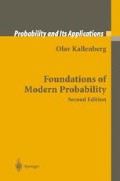Abstract
Semigroups, resolvents, and generators; closure and core; Hille-Yosida theorem; existence and regularization; strong Markov property; characteristic operator; diffusions and elliptic operators; convergence and approximation
Access this chapter
Tax calculation will be finalised at checkout
Purchases are for personal use only
Preview
Unable to display preview. Download preview PDF.
References
Semigroup ideas are implicit in Kolmogorov’s pioneering (1931a) paper, whose central theme is the search for local characteristics that will determine the transition probabilities through a system of differential equations, the so-called Kolmogorov forward and backward equations. Markov chains and diffusion processes were originally treated separately, but in (1935) Kolmogorov proposed a unified framework, with transition kernels regarded as operators (initially operating on measures rather than on functions), and with local characteristics given by an associated generator.
Kolmogorov’s ideas were taken up by Feller (1936), who obtained general existence and uniqueness results for the forward and backward equations. The abstract theory of contraction semigroups on Banach spaces was developed independently by Hille (1948) and Yosida (1948), both of whom recognized its significance for the theory of Markov processes. The power of the semigroup approach became clear through the work of Feller (1952, 1954), who gave a complete description of the generators of one-dimensional diffusions. In particular, Feller characterizes the boundary behavior of the process in terms of the domain of the generator.
The systematic study of Markov semigroups began with the work of Dynkin (1955a). The standard approach is to postulate strong continuity instead of the weaker and more easily verified condition (F2). The positive maximum principle appears in the work of ITO (1957), and the core condition of Proposition 19.9 is due to S. Watanabe (1968).
The first regularity theorem was obtained by Doeblin (1939b), who gave conditions for the paths to be step functions. A sufficient condition for continuity was then obtained by Fortet (1943). Finally, Kinney (1953) showed that any Feller process has a version with rcll paths, after Dynkin (1952) had obtained the same property under a Hölder condition. The use of martingale methods for the study of Markov processes dates back to Kinney (1953) and Doob (1954).
The strong Markov property for Feller processes was proved independently by Dynkin and Yushkevich (1956) and by Blumenthal (1957) after special cases had been considered by Doob (1945), Hunt (1956), and Ray (1956). Blumenthal’s (1957) paper also contains his zero-one law. Dynkin (1955a) introduced his “characteristic operator,” and a version of Theorem 19.24 appears in Dynkin (1956).
There is a vast literature on approximation results for Markov chains and Markov processes, covering a wide range of applications. The use of semigroup methods to prove limit theorems can be traced back to Linde-BERG’s (1922a) proof of the central limit theorem. The general results in Theorems 19.25 and 19.28 were developed in stages by Trotter (1958a), Sova (1967), Kurtz (1969, 1975), and Mackevicius (1974). Our proof of Theorem 19.25 uses ideas from J.A. Goldstein (1976).
A splendid introduction to semigroup theory is given by the relevant chapters in Feller (1971). In particular, Feller shows how the one-dimensional Lévy-Khinchin formula and associated limit theorems can be derived by semigroup methods. More detailed and advanced accounts of the subject appear in Dynkin (1965), Ethier and Kurtz (1986), and Dellacherie and Meyer (1975–87).
Author information
Authors and Affiliations
Rights and permissions
Copyright information
© 2002 Springer Science+Business Media New York
About this chapter
Cite this chapter
Kallenberg, O. (2002). Feller Processes and Semigroups. In: Foundations of Modern Probability. Probability and Its Applications. Springer, New York, NY. https://doi.org/10.1007/978-1-4757-4015-8_19
Download citation
DOI: https://doi.org/10.1007/978-1-4757-4015-8_19
Publisher Name: Springer, New York, NY
Print ISBN: 978-1-4419-2949-5
Online ISBN: 978-1-4757-4015-8
eBook Packages: Springer Book Archive

